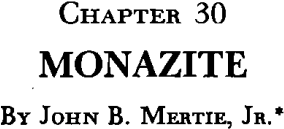Table of Contents
Monazite formerly was described as moribund, but, in the light of recent developments, it is no longer so. It is the common source of the rare earths and thorium, both of which are becoming progressively important in industrial and other applications. Moreover, by the action of foreign governments, the sources on which the United States has depended for its supply are now either restricted or cut off entirely. Monazite has thus become a scarce mineral and processors in this country are endeavoring to acquire it from all available sources.
Characteristics of Monazite
Monazite is a mineral of mystery. It is a monoclinic phosphate of the rare earths, with the general formula XPO4, but it contains also from zero to 20 pct, commonly 4 to 10 pct, of thoria. Analyses show the presence of silica in amounts ranging from very small quantities to 10 pct and also of numerous other nonradioactive elements. The radioactive elements that result from the disintegration of thorium are necessarily present, as is also a stable form of lead, Pb. Uranium also occurs commonly in small amounts, associated with thorium, for which reason its decomposition products are also present. Probably it is no accident that all these elements occur in one mineral, and it is possible that they may be the products of some process of natural fission that occurred in the remote past.
The rare earths are divided chemically into three groups known as the cerium, terbium and yttrium earths. Cerium, lanthanum, neodymium, and praseodymium, of the cerium earths, are the usual rare-earth elements in monazite. Samarium, of the same group, is less commonly present, and prometheum, though first detected in monazite, is exceedingly scarce. Some of the elements of the terbium and yttrium groups may also be present but ordinarily not all of them. Scandium is rarely present.
Occurrence of Monazite
United States
Monazite in small amounts is common in some granite, granite gneiss, and related pegmatites, and therefore has been described from many localities throughout the world. It is reported as a primary mineral from many of the eastern states from New England to Georgia; from the Black Hills, Arkansas and Texas; and from a number of western states in the Cordilleran province. Commercial deposits, however, both in this country and abroad, are restricted almost entirely to placers.
Uses
Carl Auer, Baron von Welsbach, the Austrian scientist, patented the Welsbach gas mantle in 1885. Thereafter for 25 years monazite was used mainly for its content of thorium, but the introduction of the tungsten lamp about 1911 soon rendered the gas mantle obsolete in the United States. A thriving trade in gas mantles for foreign countries still persisted but the use of thorium for this purpose gradually declined.

